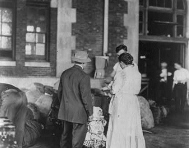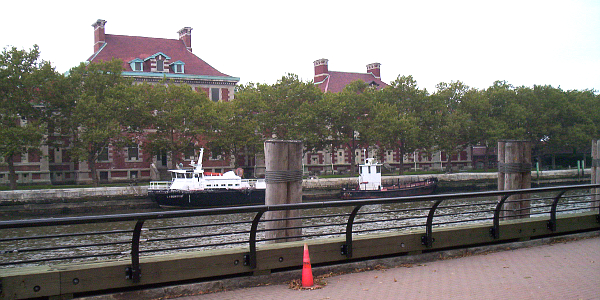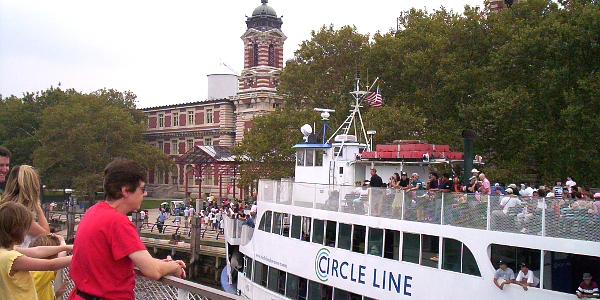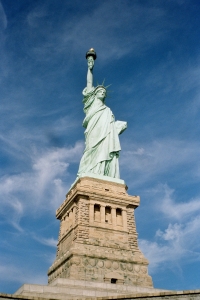
An immigrant family on Ellis Island, March 1917. Photo courtesy of the Library of Congress Prints and Photographs.

Ellis Island
Six years after the Statue of Liberty graced New York harbor, the journey of each of the twelve million immigrants would pass the statue and head toward the immigration center built just to its north. The processing station for Federal immigrants on Ellis Island, with its buildings that housed the dreams and goals of those that had endured such hardship to get to the United States, waited. They say that today over one hundred million citizens of the United States can trace their ancestors back to the walls of Ellis Island between the years of its operation from 1892 to 1954.
Sponsor this page. Your banner or text ad can fill the space above.
Click here to Sponsor the page and how to reserve your ad.

Ellis Island Then
The Journey to America - Prior to reaching the immigration center, each immigrant had to withstand a one week to one month journey from the port of embarkation on a steamship that packed people into steerage like sardines to a can. Whether they came from Sicily or Hamburg, Wroclaw or Russia, the condition on these ships were horrid, with limited facilities and comforts. This was big business for the steamship companies, but real life for each person who saw the shining example of America as a way to escape the difficult and brutal conditions in their home countries.
Immigration - Prior to 1892, immigration into the New York area was a state issue, processed with noted curruption at the Castle Garden complex, now Castle Clinton, in Manhattan. This changed in 1892 when Ellis Island opened. The original structure, which burned to the ground in 1897, taking many records with it, began a federal process that would take in twelve million immigrants until 1954. By 1907, as many as eleven thousand immigrants would come to Ellis Island every day for processing. 1907 also saw the highest amount of immigrants processed through Ellis Island of any year, eight hundred and sixty thousand.
The New Building - By December 17, 1900, the new building, which still sits on the island today as the main visitor center and museum, began to take in immigrants. For most, this process was a one day affair, with medical examinations and a recounting of the details of each applicant against their manifest answers. If this, plus meeting a requirement of having $25 in their possession in order to start a new life, was in order, the immigrant was free to go and make their life in America. Twelve million people would pass through the doors of Ellis Island, which today accounts for over one hundred million citizens of the United States.
Photo above: Ellis Island as scene from the ferry as you approach. Below: Other buildings of Ellis Island across from the currently open visitor area.

Ellis Island Now
Today, the national park known as Statue of Liberty National Monument contains two national treasures, the buildings of Ellis Island and those of the Statue of Liberty island. Both of these national treasures are open to the public; Ellis Island being the new addition in 1990 after an extensive renovation. Its sister island, with the beacon of liberty, has welcomed visitors for over one century.
For the island of Ellis, the journey would take longer, six years to begin its role as the processing center for European immigrants and nearly one hundred more to open to the public as a museum to that role. In previous incarnations, this island has seen a journey from a private tavern in the middle of the bay to Fort Gibson, a fortification during the War of 1812 to protect Manhattan from the British to an arsenal. Finally, after years of a desire to take immigration from the province of the states and into Federal hands, it was decided to erect the Ellis Island Immigration Center on the site of Fort Gibson. The structure would open on January 1, 1892 and serve in this purpose until 1954. The current building would be erected in 1900 after a fire destroyed the first and the island would grow from its inception acreage of three to the thirty-three acre complex that included dormitories and a hospital complex that rivaled any in the world.
The Restoration - For thirty-six years, the halls of Ellis Island were devoid of activity. Closed in November 1954 after the process of immigration had been transferred to the consulate level in each immigrant nation in 1924 and the other uses of Ellis Island, including a World War II detainment center, Ellis Island began to deteriorate in the harbor of New York until September 10, 1990 when its restoration and inclusion into The Statue of Liberty National Monument was completed. Today over four million people per year walk the same halls where their ancestors trod, with trepidation, into a new world.
The Immigrant Experience at Ellis Island - After the steerage company dropped its main passengers off in Manhattan, ferries would transport the steerage immgrant passengers to the processing center at Ellis Island. Not unlike the transport of visitors today, this journey, only fifteen minutes or so, would expose the immigrant to the sites of the Statue of Liberty and the buildings of Manhattan. Once at Ellis Island, the immigrant families would pass through the doors into the first floor entry, drop their baggage, and head for the registry room on the second floor after a climb up one flight of stairs. Stairs both up and down at Ellis Island were important tests for each man, woman, or child. As they climbed, each immigrant was given a six second medical examination by examiners who stood at its apex, looking for those that may have been sick or unable to provide for themselves in America. Ninety-eight percent of the immigrants would eventually pass this test. At the other end of the registry hall, steps down would segment those who would head to New York or other locations in the states, however, for those that had not passed the various requirement tests, they would head down the center aisle toward deportation back to the country of origin.
Ellis Island Hospital - For most immigrants who were deemed ill during the six second exam, hospitalization in the modern facility across the dock from the main building for several days was all that was necessary to allow them entrance in to the United States. The hospital at Ellis Island was considered one of the best in the nation. The hospital buildings are not open for visitation at this time.
T-Shirts and Souvenirs

Ellis Island T-Shirts and Souvenirs from the official merchandise of America's Best History.

Ellis Island
Things You Should Not Miss
1. The film, "Tears of Hope, Eyes of " a thirty minute film told in immigrant voices within two theatres of the main building of Ellis Island. This film is free. Get your tickets at the ranger station in the main lobby of the Ellis Island building.
2. Take the ranger guided tour of Ellis Island. This forty-five minute walk, both outside and inside the main Ellis Island building, explains both how the center originated, as well as how the immigrant went through their day or days of indoctrination. Ask about the six second medical exam.
3. Take a moment to gaze onto the horizon. From every direction of both Ellis Island and Liberty Island, you can view a slice of America. From the concrete canyons of Manhattan, to the fort of Governor's Island, to Queens and Brooklyn, Staten Island, and the docks of Jersey City.
Photo above: Outgoing tourists on the ferry from Ellis Island to the Statue of Liberty as another ferry brings tourists to the immigration center. Ferries can be taken from both the Castle Clinton area of southern Manhattan and Liberty State Park in New Jersey.

Get Baseball History and Books at Stat Geek Baseball, including Baseball's Best @ 150, the book that counts downs over 8,000 of the best batters, pitchers, and fielders in the first 150 years of Major League Baseball (1871-2020).
Visitor FAQ

Statue of Liberty and Ellis Island Links
Statue of Liberty National Monument
Ellis Island National Monument
Statue of Liberty and Ellis Island Ferry Service
Statue of Liberty/Ellis Island Foundation



